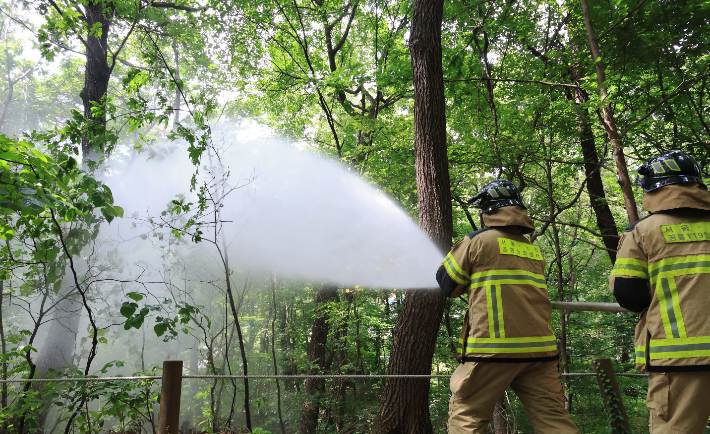[Feature] Will Lovebugs Return Next Year?
Lovebugs once again filled
cities across Korea for weeks this year. Although most have now disappeared,
the issue remains unresolved. The number
of lovebugs continues to rise annually, yet effective measures have not been implemented
to control them. Practical solutions are urgently needed to reduce the risk of
recurring outbreaks.

Hikers wave their hands to fend off lovebugs
Photo: Yonhap News (yna.co.kr)
Lovebugs
Spread Across the Seoul Metropolitan Area Again
The number of citizen complaints in Seoul
about lovebugs has skyrocketed this year. According to the Seoul Metropolitan
Government, the number grew from 4,418 cases in 2022 to 5,600 in 2023, then
jumped to 9,296 in 2024. In just the first half of this year, more than 4,600
cases have already been reported, indicating that this year could break all
previous records.
In recent years, large swarms have been
reported in green spaces and mountainous areas such as Gyeyangsan Mountain in
Incheon and Inwangsan Mountain in Seoul, causing serious inconvenience to
hikers and nearby residents. One visitor to Gyeyangsan
Mountain described how lovebugs clung to hats,
arms, clothing, and even masks simply by standing on the trail, forcing them to
shake the insects off and cut their hike short.
As lovebugs began swarming urban areas in massive numbers, some people even began eating them. In one viral video posted on July 3, a YouTuber who has 1.56 million subscribers collected thousands of lovebugs from Gyeyangsan Mountain and brought them home to cook. The video quickly drew millions of views and sparked a heated debate online.
Why Are Lovebugs Increasing in Numbers?
Lovebugs were not common in Korea just a few years ago. The
species Plecia nearctica,
commonly known as the lovebug, was first recorded in Korea in 2015, when a few
individuals were collected in Incheon. A subsequent collection occurred in
2019, but it was not until 2022 that the insect drew public attention after a
large-scale outbreak in Bongsan Mountain, Eunpyeong-gu. Since then, the
presence of lovebugs has continued to grow. In 2023, they were spotted in
swarms at the summit of Bukhansan Mountain, and in 2024, a major outbreak in
Gyeyangsan Mountain in Incheon, again raised concerns. As of this year, their
range has expanded even further, reaching Nowon-gu in Seoul and the neighboring
city of Guri.
A combination of ecological and
environmental factors appears to be behind the recent surge in Korea’s lovebug
population. Lovebugs are decomposer insects that lay eggs in soil and feed on
leaf litter and organic matter in their larval stage. As adults, they may also
serve a partial role in pollination.
Experts say the population is
spreading predominantly along green corridors rich in fallen leaves and organic
debris. Professor
Kim Dong-geon, an ecologist specializing in freshwater ecosystems and pest
management at Sahmyook University explained, “The current distribution pattern of lovebugs shows a clear tendency
to expand along green zones. The accumulation of leaf litter and organic
materials in these areas provides an ideal environment for the insects to lay
eggs and grow.”
The explosive outbreaks observed
in certain regions can also be attributed to characteristics commonly seen in
invasive species. According to Kim, invasive species tend to multiply rapidly
in their early stages of settlement because they lack natural predators in the
new environment. He noted that “flower bugs like the spotted lanternfly
followed a similar pattern when first introduced to Korea—but their population
eventually declined once parasitic wasps appeared as natural enemies. In the
case of lovebugs, however, that balance has yet to occur.”
He also suggested that the initial
discovery in Incheon may be linked to common entry points for invasive species.
“Ports and airports often serve as gateways for foreign species, and the fact
that lovebugs were first detected in Incheon is likely not a coincidence,” he
added.

The Lovebug Problem: Growing
Numbers, Few Answers
Despite growing concern, effective
countermeasures remain limited. While lovebugs serve a role in breaking down
organic matter and even contribute slightly to pollination, they are still an
invasive species. Kim emphasized, “Even if an organism seems beneficial,
invasive species must be carefully monitored and managed.”
However, excessive use of pesticides could make things worse. "Lovebugs are known to possess genetic
resistance to pesticides, so excessive chemical use might only strengthen their
survival,” Kim warned, urging for environmentally friendly pest control and
long-term monitoring as more sustainable solutions.
While lovebugs are not
disease-carrying insects, large swarms can still create secondary hygiene
problems. Their carcasses may attract rats, flies, and cockroaches, potentially
leading to further infestation. There is also a small risk of allergic reactions
in individuals sensitive to chitin, a structural protein found in the insect's
exoskeleton. In rare cases, accidental ingestion could cause immune responses
similar to shellfish allergies.
Lovebugs may have vanished for now, but they are likely to return in even greater numbers next summer. Rather than relying on heavy pesticide use, sustainable control measures based on solid ecological research are needed. It depends on constructive collaboration between public authorities and scientific experts, as well as a broader shift in public attitudes toward urban ecology.
There are no registered comments.
I agree to the collection of personal information. [view]

